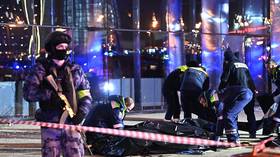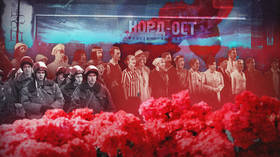What happened to the victims of the largest terrorist attack in Russian history during the two days they were held hostage?
After the rapid seizure of School No. 1 in the southern Russian city of Beslan by terrorists in September 2004, difficult days began for the entire country. While the hostages suffered from a lack of water and food in the constant fear that their lives could end at any moment, the entire country held its breath in anticipation of what decisive steps the authorities would take to save the children.
This feature is the second part of the Beslan trilogy, in which RT tells the detailed story of the crime that shocked Russia and the world 20 years ago. Read about what led to this tragedy and how the terrorists managed to seize 1,128 hostages, most of whom were children, in the first part.
Day 1: Terrorists turn the school into a fortress
The hostages were taken into the school gym, where explosives were immediately set up. The individual who placed the bombs was an Arab militant, one of six unidentified terrorists. The bombs that were placed around the hostages were wired together in a single chain and activated by a switch. If the weight on the switch was lifted (the terrorists served as the weight by standing on the pedal in shifts) an electric current would detonate all the bombs simultaneously. Wires also stretched outside, allowing the leader of the gang of terrorists, Ruslan Khuchbarov, to detonate the chain remotely. Most of the explosives were created from powerful military anti-personnel mines. When activated, everything would blow up at once, killing everyone inside. However, due to the devilishly clever design of the mechanism, it was impossible to kill the terrorist standing guard without detonating all the bombs.
The terrorists immediately confiscated everyone’s mobile phones. After the terrorists threatened to execute 20 hostages if they heard a ringtone, the last few prisoners who had hoped to keep their phones tossed them away in panic.
Next, the terrorists outlined their demands. A note was sent to the authorities outside the school, calling for politicians to be brought in for negotiations, and specifying that hostages would be killed if anyone attempted to shoot at the terrorists or if communication or power were cut off. The note was carried out by the mother of one of the children; her teenage son was held at gunpoint, ready to be shot if she tried to escape.
Military forces arrived in Beslan from all directions. A military medical battalion was set up near the town. Soldiers surrounded the school but kept their distance, since at the sound of the slightest movement, gunfire was heard inside the school. Operational headquarters were established onsite, headed by Valery Andreev, the head of the FSB branch in North Ossetia.
Meanwhile, Khuchbarov barricaded the windows and doors of the school. He forced the adult male hostages to rearrange the school furniture. Once the task was completed, groups of men were taken upstairs to the literature classroom…
When hostage Aslan Kudzaev was taken into the room, the first thing he saw was the bodies. These were the remains of the men who had come there earlier, and who were shot right there in the classroom. He and another hostage were ordered to throw the corpses out the window. Beneath the window lay even more lifeless bodies. As Aslan and his companion dragged the bodies away, the gunman started reloading his weapon. Seizing the moment, Kudzaev jumped onto the windowsill and leapt out. The soldiers outside hesitated to shoot, but tossed smoke grenades; the terrorist who fired at him missed, and limping, Kudzaev managed to escape. His family was very fortunate – his wife and daughter both survived.
Ruslan Gappoev was not so lucky. Learning that his wife and daughter had been taken hostage, he rushed toward the school in desperation and broke through the police barricade – only to be shot by the terrorists. His daughter, Dzerassa, died two days later.
At this point, over 20 people had already died at School No. 1, but the horror was just starting. Khuchbarov, meanwhile, had encountered problems with the female suicide bombers. One of them, Mariyam Taburova, believed that they were supposed to seize a police station. When she realized what she was supposed to do, she broke down. What happened next remains unclear. Khuchbarov may have blown her up remotely – after all, remote activation devices for suicide belts were standard for terrorists in the Caucasus; or she may have pressed the button herself. Regardless, the bomb exploded, killing her, another suicide bomber, a terrorist, and also hostage Ivan Karlov.
A bloody first day of September was drawing to a close.
Day 2: Torture, abuse and attempted negotiation
The morning of the second day saw several significant developments. First and foremost, the children in the school were denied water and were no longer allowed to use the restroom. This effectively meant a slow death. North Ossetia is located in southern Russia, where temperatures can be scorching in early September. The terrorists had crammed over 1,000 people into a small gym, shut the windows tightly, and didn’t allow them any water. As the hostages began to relieve themselves on the floor – there was no other option – the gym turned into a hellish prison. Thirst became unbearable. By midday, many people were resorting to drinking their own urine out of desperation.
By 4 pm, former Ingush President Ruslan Aushev was allowed to enter the school. Aushev was quite influential in Ingushetia, and even though he hadn’t been initially invited for negotiations, the terrorists agreed to speak with him. However, the president of North Ossetia, Alexander Dzasokhov, wasn’t allowed to enter the school. It was clear that the terrorists aimed to incite ethnic violence between the Ossetians and Ingush, and the operational command feared that he would simply be killed by the terrorists.
Through Aushev, the terrorists communicated their political demands, which included ending the military operation in Chechnya, withdrawing troops, and granting immediate independence to the region. They insisted that negotiations should be held with Aslan Maskhadov, the formal president of Chechnya. Additionally, Khuchbarov agreed to release infants and their mothers. The pre-schoolers, who could not understand the situation, cried incessantly and were making the terrorists nervous. In total, 26 hostages were released.
One of the most poignant photographs of the Beslan attack was taken when police officer Elbrus Gogichaev carried six-month-old Alena Tskaeva out to safety. Her mother remained inside the school with two other children, and along with Alena’s older sister was killed the following day. To this day, the surviving members of the Tskaev family and Gogichaev remain friends.
Meanwhile, the operational command was frantically searching for a way out of the nightmare. To say that the situation was dire would be an understatement. In 1999, when the war resumed, Russia officially refused to negotiate with Maskhadov. But by now the circumstances had changed dramatically.
However, attempts to reach Maskhadov were fruitless. Dzasokhov and journalist Anna Politkovskaya both tried to contact him but received no response.
No one knew what was going on in Maskhadov’s mind.
Basayev had presented Maskhadov with a ‘gift’ that the latter neither expected nor wanted. He couldn’t even be sure that the terrorists would want to talk to him at all. Khuchbarov told Aushev that negotiations with Maskhadov should focus on withdrawing troops and recognizing Chechnya’s independence, not on freeing hostages. The president faced a number of risks.
Eventually, Maskhadov chose to do nothing. During the Beslan hostage crisis he remained silent and made no effort to intervene.
The second day was the hardest – it felt like endless waiting. The terrorists acted unpredictably and their mood often changed. At one point, one of the militants wanted to let the hostages listen to music but then changed his mind. Another terrorist lectured boys about causing discomfort to an elderly hostage by lying on the floor in the wrong way. The hostages were beaten. Some children were tortured by being forced to sit for hours “like rabbits” – with their hands behind their heads. After some time, their muscles cramped, inflicting great pain. “We were left guessing whether we’d be executed or entertained; it felt like a theater of the absurd,” one of the hostages grimly joked.
By the evening of September 2, people were on the brink of madness from the heat, lack of water, and the terrible stench. Suddenly, one of the terrorists seemed to regain some semblance of humanity and allowed a few children to go to the bathroom where there was water. Khodov yelled at the “humanist” and beat an 11-year-old boy whom he found drinking, but at least he didn’t kill anyone.
Trying to end the nightmare
Meanwhile, outside, the situation was equally chaotic. People flocked to Beslan from all over Ossetia. Since the Ossetian-Ingush conflict in the 1990s, many people stored weapons in their homes – mostly hunting rifles, but there were plenty of military-grade guns and even light machine guns as well. This impromptu local militia was now roaming the streets, and the authorities had no control over them in any way. The terrorists were offered money, a safe passage out, any possible option so they would release the hostages, but it was all useless.
By the evening of September 2, there were several possible scenarios of what could happen, and all of them were disastrous. A storming operation would lead to heaps of bodies – mostly of children. Yet, if nothing was done, those same kids would die from dehydration and exhaustion. Negotiating with Maskhadov sounded optimal, but where was he? The criminals were psychologically exhausted. They were religious fanatics and monsters who controlled the bombs that threatened everyone’s lives, and anything could trigger them.
An FSB counter-terrorism unit had already arrived in Beslan. After a series of reforms, this unit became known as the FSB Special Purpose Center but most people still referred to its two main divisions by their old names: Alpha and Vympel. These units had a long history, dating back to their formation in the Soviet times, in the 1970s. They handled standard counter-terrorism operations. Storming a bus or plane seized by a small group of armed terrorists was routine for them. In such scenarios, Alpha and Vympel were as capable as any elite foreign counterterrorism unit, like Germany’s GSG-9, Israel’s Yamam, or France’s GIGN. But there was nothing standard about the situation in Beslan. The chain of explosives made it nearly impossible to carry out a storming operation without bloodshed, yet avoiding it altogether was not an option either.
Russian military officials unofficially said that a storming operation would have been carried out on the night of September 4 regardless of the course of events. It was the most logical option: the terrorists would be at their weakest at that point, and the cover of night offered a tactical advantage for the special forces equipped with night-vision gear. No matter how slim the chances were, they were greater at night. The Alpha and Vympel units planned to dedicate September 3 to preparing for the operation. But reality caught up with them.
The denouement of the protracted tragedy was rapidly approaching.
To be continued…
The final part of the story will be published on RT on Friday, September 20




